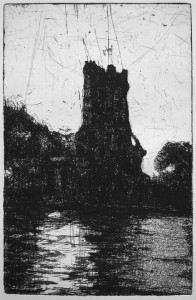
The “speckling” pattern inSilhouette of Boldt Castle shows how a thick mist of spray paint can protect white dots on the surface while surrounding areas are deeply etched. (A finer mist wouldn’t be as noticeable)
Aquatint
Aquatint is another intaglio technique which also involves etching. Once the initial etched line drawing is completed on the copper plate, to add tones, one process I use is called aquatint. More specifically, I use a spraypaint aquatint. A very thin layer of spraypaint is applied to the plate (a mist so fine that to see it, you must look very closely). The small paint drops protect those very small areas of the plate. Once dried, areas that are to remain white must be covered so they are not etched. I use a chemical called “stop-out” although hard ground can also be used. The plate is then placed in the ferric chloride bath to etch “gray” tones. The longer the plate is left in the bath, the darker the tones will get. Once the lightest gray tone is achieved (etching time vary greatly, most of the time it is experimental), the plate must be removed from the bath and the lightest gray areas covered with stop-out or hard ground and the process is continued until the darkest gray, or black, is achieved.
If one were try to create tones on a copper plate without using anything on the surface like an aquatint, flat or foul biting will occur. The plate will have etched, but because the surface is still the same, it will be difficult for ink to hold onto the surface.
If one were try to create tones on a copper plate without using anything on the surface like an aquatint, flat or foul biting will occur. The plate will have etched, but because the surface is still the same, it will be difficult for ink to hold onto the surface.
